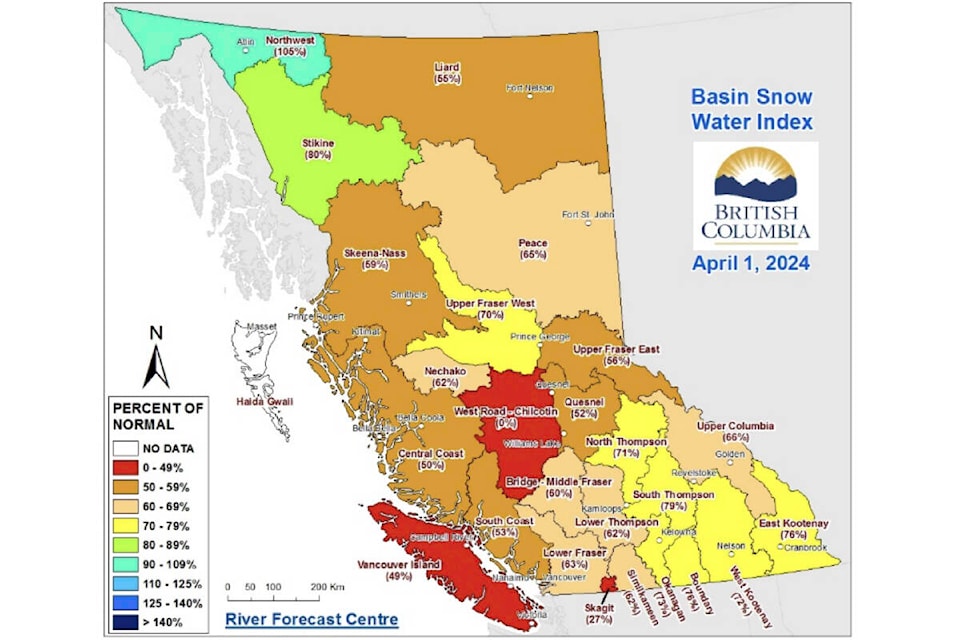The latest snowpack update from the B.C. River Forecast Centre, which was released on April 10, shows that the provincial snowpack is at the lowest level since 1970 for April 1, raising serious concerns about the prospect of drought.
The report shows that province-wide, snowpack levels are at 63 per cent of normal on average, the lowest recorded figure for April 1. Jonathan Boyd, a hydrologist with the River Forecast Centre, said that while 1970 is the earliest year they have full provincial data for, it’s possible that this month’s levels break even older records.
The April 1 figure is down three per cent from the 66 per cent recorded on March 1 and is an even more significant drop from April 1, 2023, when the snowpack was 88 per cent of normal. The previous recorded low point for April 1 was in 2015, when levels were at 66 per cent of normal.
While experts say that it is too soon to say with certainty what will happen, the April report states that dry conditions persisted throughout the province through much of March, with many locations in the Northern and Interior regions measuring near record low precipitation last month.
A below-normal spring freshet flood hazard is expected this season due to the low snowpack, although local flooding from extreme rainfall is possible. However, the report states that “Low snowpack and seasonal runoff forecasts, combined with warm seasonal weather forecasts and lingering impacts from ongoing drought, are creating significantly elevated drought hazards for this upcoming spring and summer.”
Boyd noted on April 10 that many factors contribute to droughts. “It’s a little bit too early to say with definity that we will for sure have a major drought this year,” he said, adding that experts consider April’s snow survey and water bulletin to be the “premier” report for assessing the year’s seasonal snowpack and historical comparisons. “Typically, by April 1, about 95 per cent of the seasonal snowfall has accumulated.”
While snow levels could continue to accumulate into May, the snowpack so far has followed the patterns of a typical El Niño year, with a warmer-than-normal and sometimes drier-than-normal winter, Boyd said.
“It’s not setting up for a great season, but it just depends on what the weather conditions are,” he added. “If we have last year’s spring weather conditions this year, it will be worse from a drought perspective.”
Regions with the lowest snowpack currently include the Chilcotin (0 per cent of normal) and Vancouver Island (49 per cent of normal). Areas along the central and southern coast, Skeena-Nass, the Northeast, and the Upper Fraser East and Quesnel regions all sit between 50 and 59 per cent of normal.
The Lower Thompson is at 62 per cent of normal, with the North Thompson at 71 per cent and the South Thompson at 79 per cent. The Fraser River at Hope snow basin is “well below” normal at 61 per cent.
Overall, the River Forecast Centre described snowpack levels as “extremely low” and warned that this, combined with a forecast of above normal spring and summer temperatures, could lead to “significantly elevated drought hazards.”
But Boyd said it’s still possible that things could change in the weeks to come. He pointed to years, such as 2022, that experienced drought despite a healthy snowpack and years, such as 2019, when predictions of drought did not materialize because of summer precipitation, which led to serious flooding.
Many local governments around the province are taking steps to decrease water consumption in advance of the summer. At its April 2 meeting, Cache Creek council voted — by a three to one margin with Mayor John Ranta opposed — to begin Stage 1 water restrictions as of April 1, rather than on May 1 as usual.
In Ashcroft, council voted unanimously at its April 8 meeting to go directly to Stage 2 water restrictions on May 1, bypassing Stage 1 altogether. The City of Kamloops has implemented a new Water Use Restriction Plan that is in effect year-round, and allows residents to water three days per week, replacing the previous seasonal model that allowed residents to water on an odd-even schedule based on their street address during the spring and summer months, with unrestricted watering at other times.
Metro Vancouver has taken an even stricter approach. As of May 1, residents there can only water their lawns on one day per week.
“Last year, we had to ban lawn watering mid-summer because use of our treated drinking water for outdoor use was too high,” said Malcolm Brodie, chair of Metro Vancouver’s water committee, in a statement.
“This year, we’re hoping to avoid escalating restrictions for as long as possible, but it really depends on you. Let your lawn go brown this summer, and save water for where it’s needed most: cooking, cleaning, and drinking.”
Nathan Cullen, minister of water, land and resource stewardship, said in a statement that the latest levels are “concerning news.”
“Communities around B.C. experienced serious drought conditions last summer,” he said. “It fuelled the worst wildfire season ever, harmed fish and wildlife, and affected farmers, ranchers, First Nations, and industry.”
But although the current snowpack level is “not good,” Cullen also warned against too much gloom and doom. “There [are] a lot of things we can do individually, collectively, at different orders of government,” he said.
Businesses and individuals will also have to play their part, he added. Heavy industrial water users have already faced restrictions, he noted, adding “But we are trying to stay away from water restrictions as best as we can.”
With files from Barbara Roden
